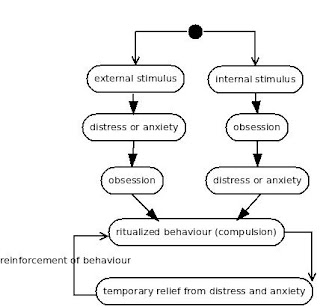In this paper, we choose to use
a general-purpose modeling language in the field of software engineering, which is
designed to provide a standard way to visualize the design of a system. This
later is called UML standing for Unified Modeling Langage [James Rumbaugh, Ivar
Jacobson, and Grady Booch. 2004. Unified Modeling Language Reference
Manual, the (2nd Edition). Pearson Higher Education]. Due to space
limitations of the paper, we do not detail the formalism of the language, and
hope that the instanciation and use of this later in our study case will be
sufficient for the reader.
Unified modeling langage modeling of obsessive compulsive disorder
In this chapter, we present two
different types of UML diagram : activity diagram, and state machine
diagram to help describe a model of obsessive compulsive disorder.
A. Activity Diagram of OCD
In this section, we give a
activity diagram of the obsessive compulsive disorder. This diagram has the
particular ability to describe
« activity » (volountary/wanted/decided ones/ and others).
In the previous figure, we make two
assumption, the first one is that the feeling of guilt is the result of the
synchronisation of two internal stimulus and action : the first one is a
specific belief, and the second one is an action that goes at the opposite
sense of that belief.
The second assumption is that, going to
an obsession state, or anxiety state, can be the result of a decision
(depending of the psychological background of the subject).
B. State Machine Diagram of OCD
In this section, we give a
« state machine » diagram of the obsessive compulsive disorder. This
diagram has the particular ability to
describe « state » (used here for « mind state » which may
be considered as unvolountary/unwanted/undecided activities)
Fig. 1. State machine
diagram of the OCD disorder.
Confronting cognitive/behavioral therapy and disorder
In this chapter, we will detail our
contribution, a fault-tolerant based approach to confront the OCD
« model » (considered here as a cognitive/behavioral disorder)
inside/through the islamic prayer « model » (considered here as a
cognitive/behavioral therapy). Finally, we give conclusions and give further
possibilities and application of our work.
Conclusion : we distinguish between
two paths corresponding to the two possibilities of stimulus. In the first
case, an external stimulus leads to a distress and/or anxiety state, then to
obsession. In the second case, an internal stimulus leads to obsession, then
to distress and/or anxiety (due to culpability feeling). Both cases result by
a ritualized behaviour (compulsion) (state C), and to a temporary relief from
anxiety and/or distress, BUT this later one will LOOP to state (C) causing a
reinforcement of state (C). As a result, the state/transition diagram has no
FINAL state, and will loop indefinetly, this is litterally a state diagram
disorder and explain the obsessive-compulsive disorder appellation, and which
explain the complexity of curing such disorder due to the difficulty of
escaping such the loop described previously.





No comments:
Post a Comment